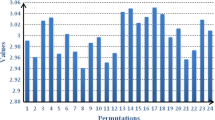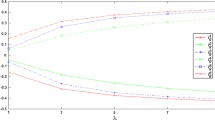Abstract
For decision makers, expressing their opinions through subintervals of [0, 1] is sometimes easier than using crisp numbers. This study defines some outranking relations derived by ELECTRE III for hesitant interval-valued fuzzy sets (HIVFSs). The properties of these outranking relations are discussed in detail. The concordance and discordance indexes of HIVFSs are then proposed. Ranking approach is developed based on the outranking relations of HIVFSs to handle multi-criteria decision-making problems. Finally, we provide practical examples, as well as sensitivity analysis and comparison with other techniques.
Similar content being viewed by others
References
Achillas C, Vlachokostas C, Moussiopoulos N, Banias G (2010) Decision support system for the optimal location of electrical and electronic waste treatment plants: a case study in Greece. Waste Manag 30(5):870–879
Atanassov KT (1986) Intuitionistic fuzzy sets. Fuzzy Sets Syst 20(1):87–96
Bellman R, Zadeh LA (1970) Decision making in a fuzzy environment. Manag Sci 17:141–164
Bojković N, Anić I, Pejčić-Tarle S (2010) One solution for cross-country transport-sustainability evaluation using a modified ELECTRE method. Ecol Econ 69(5):1176–1186
Cao Y, Zhou H, Wang J (2016) An approach to interval-valued intuitionistic stochastic multi-criteria decision-making using set pair analysis. Int J Mach Learn Cybern. doi:10.1007/s13042-016-0589-9
Cavallaro F (2010) A comparative assessment of thin-film photovoltaic production processes using the ELECTRE III method. Energy Policy 38(1):463–474
Chen N, Xu ZS, Xia MM (2013) Interval-valued hesitant preference relations and their applications to group decision making. Knowl Based Syst 37:528–540
Devi K, Yadav SP (2013) A multicriteria intuitionistic fuzzy group decision making for plant location selection with ELECTRE method. Int J Adv Manuf Technol 66(9):1219–1229
Farhadinia B (2014a) Correlation for dual hesitant fuzzy sets and dual interval-valued hesitant fuzzy sets. Int J Intell Syst 29:184–205
Farhadinia B (2014b) Distance and similarity measures for higher order hesitant fuzzy sets. Knowl Based Syst 55:43–48
Figueira JR, Almeida-Dias J, Matias S, Roy B, Carvalho MJ, Plancha CE (2011) Electre Tri-C, a multiple criteria decision aiding sorting model applied to assisted reproduction. Int J Med Inform 80(4):262–273
Hanandeh AE, El-Zein A (2010) The development and application of multi-criteria decision-making tool with consideration of uncertainty: the selection of a management strategy for the bio-degradable fraction in the municipal solid waste. Bioresour Technol 101(2):555–561
Hartati S, Wardoyo R, Harjoko A, Palembang-prabumulih J, Ilir O (2011) Electre methods in solving group decision support system bioinformatics on gene mutation detection simulation. Int J Comput Sci Inf Technol 3(1):40–52
Haurant P, Oberti P, Muselli M (2011) Multicriteria selection aiding related to photovoltaic plants on farming fields on Corsica island: a real case study using the ELECTRE outranking framework. Energy Policy 39(2):676–688
Hokkanen J, Salminen P (1997) ELECTRE III and IV decision aids in an environmental problem. J Multi Criteria Decis Anal 6(4):215–226
Hu BQ (2016) Three-way decision spaces based on partially ordered sets and three-way decisions based on hesitant fuzzy sets. Knowl Based Syst 91:16–31
Hu JH, Yang Y, Chen XH (2017) A novel TODIM method based three-way decision model for medical treatment selection. Int J Fuzzy Syst. doi:10.1007/s40815-017-0320-3
Ji P, Zhang HY, Wang JQ (2017) Fuzzy decision-making framework for treatment selection based on the combined QUALIFLEX-TODIM method. Int J Syst Sci. doi:10.1080/00207721.2017.1357779
Jin FF, Ni ZW, Chen HY, Li YP, Zhou LG (2016) Multiple attribute group decision making based on interval-valued hesitant fuzzy information measures. Comput Ind Eng 101:103–115
Kaya T, Kahraman C (2011) An integrated fuzzy AHP-ELECTRE methodology for environmental impact assessment. Expert Syst Appl 38(7):8553–8562
Li J, Wang JQ (2017) Multi-criteria outranking methods with hesitant probabilistic fuzzy sets. Cognit Comput. doi:10.1007/s12559-017-9476-2
Marzouk MM (2011) ELECTRE III model for value engineering applications. Autom Constr 20(5):596–600
Ozcan T, Celebi N, Esnaf S (2011) Comparative analysis of multi-criteria decision making methodologies and implementation of a warehouse location selection problem. Expert Syst Appl 38(8):9773–9779
Pedrycz W (1990) Fuzzy sets in pattern recognition: methodology and methods. Pattern Recogn 23:121–146
Peng HG, Zhang HY, Wang JQ (2016) Probability multi-valued neutrosophic sets and its application in multi-criteria group decision-making problems. Neural Comput Appl. doi:10.1007/s00521-016-2702-0
Peng JJ, Wang JQ, Wu XH, Tian C (2017a) Hesitant intuitionistic fuzzy aggregation operators based on the archimedean t-norms and t-conorms. Int J Fuzzy Syst 19(3):702–714
Peng JJ, Wang JQ, Yang LJ, Qian J (2017b) A novel multi-criteria group decision-making approach using simplified neutrosophic information. Int J Uncertain Quantif 7(4):355–376
Qian G, Wang H, Feng XQ (2013) Generalized hesitant fuzzy sets and their application in decision support system. Knowl Based Syst 37:357–365
Roy B (1991) The outranking approach and the foundations of ELECTRE methods. Theor Decis 31(1):49–73
Sambuc R (1975) Fonctions phi-:oues, Application a l’Aide au diagnostic en pathologie thyroidienne, Ph.D. thesis, University o f Marseille, France
Sawadogo M, Anciaux D (2011) Intermodal transportation within the green supply chain: an approach based on ELECTRE method. Int J Bus Perform Supply Chain Model 3(1):43–65
Singh PK, Kumar CA, Li JH (2016) Knowledge representation using interval-valued fuzzy formal concept lattice. Soft Comput 20(4):1485–1502
Smarandache F (1998) Neutrosophy: neutrosophic probability, set and logic. American Research Press, Rehoboth, pp 1–105
Torra V (2010) Hesitant fuzzy sets. Int J Intell Syst 25(6):529–539
Torra V, Narukawa Y (2009) On hesitant fuzzy sets and decision. In: The 18th IEEE international conference on fuzzy systems, Jeju Island, Korea, pp 1378–1382
Vallée D, Zielniewicz P (1994) ELECTRE III-IV, version 3.x-Aspects méthodologiques. Université de Paris-Dauphine, Document du LAMSADE no 85
Wang JQ, Wang DD, Zhang HY, Chen XH (2014) Multi-criteria outranking approach with hesitant fuzzy sets. OR Spectr 36:1001–1019
Wei GW, Zhao XF (2013) Induced hesitant interval-valued fuzzy Einstein aggregation operators and their application to multiple attribute decision making. J Intell Fuzzy Syst 24(4):789–803
Wei GW, Zhao X, Lin R (2013) Some hesitant interval-valued fuzzy aggregation operators and their applications to multiple attribute decision making. Knowl Based Syst 46:43–53
Wang J, Wang JQ, Tian ZP, Zhao DY (2017) A multi-hesitant fuzzy linguistic multi-criteria decision-making approach for logistics outsourcing with incomplete weight information. Int Trans Oper Res. doi:10.1111/itor.12448
Xia MM, Xu ZS, Chen N (2013) Some Hesitant fuzzy aggregation operators with their application in group decision making. Group Decis Negot 22(2):259–279
Xu ZS (2001) Algorithm for priority of fuzzy complementary judgment matrix. J Syst Eng 16(4):311–314
Yager RR (1997) Multiple objective decision-making using fuzzy sets. Int J Man Mach Stud 9:375–382
Yu DJ, Wu YY, Zhou W (2011) Multi-criteria decision making based on Choquet integral under hesitant fuzzy environment. J Comput Inf Syst 12(7):4506–4513
Yu SM, Wang J, Wang JQ (2016) An extended TODIM approach with intuitionistic linguistic numbers. Int Trans Oper Res. doi:10.1111/itor.12363
Yu SM, Zhang HY, Wang JQ (2017) Hesitant fuzzy linguistic maclaurin symmetric mean operators and their applications to multi-criteria decision-making problem. Int J Intell Syst. doi:10.1002/int.21907
Zadeh LA (1965) Fuzzy sets. Inf Control 8:338–356
Zadeh LA (1975) Fuzzy logic and approximate reasoning. Synthese 30:407–428
Zhang N, Wei GW (2013) Extension of VIKOR method for decision making problem based on hesitant fuzzy set. Appl Math Model 37(7):4938–4947
Zhang XL, Xu ZS (2014) The TODIM analysis approach based on novel measured functions under hesitant fuzzy environment. Knowl Based Syst 61:48–58
Zhang ZM, Wang C, Tian DZ, Li K (2014) Induced generalized hesitant fuzzy operators and their application to multiple attribute group decision making. Comput Ind Eng 67:116–138
Zhou W (2014) An Accurate method for determining hesitant fuzzy aggregation operator weights and its application to project investment. Int J Intell Syst 29(7):668–686
Zhou H, Wang JQ, Zhang HY (2016) Stochastic multi-criteria decision-making approach based on SMAA-ELECTRE with extended grey numbers. Int Trans Oper Res. doi:10.1111/itor.12380
Zhu B, Xu ZS, Xia MM (2011) Hesitant fuzzy information aggregation in decision making. Int J Approx Reason 52(3):395–407
Zhu B, Xu ZS, Xia MM (2012) Dual Hesitant Fuzzy Sets. J Appl Math 11:2607–2645
Zhu JQ, Fu F, Yin KX, Luo JQ, Wei D (2014) Approaches to multiple attribute decision making with hesitant interval-valued fuzzy information under correlative environment. J Intell Fuzzy Syst 27:1057–1065
Acknowledgements
The author would like to thank the editors and the anonymous referees for their valuable and constructive comments and suggestions that greatly help the improvement of this paper. This work was supported by the National Natural Science Foundation of China (Nos. 71571193 and 71701065) and the China Postdoctoral Science Foundation (No. 2017M610511).
Author information
Authors and Affiliations
Corresponding author
Ethics declarations
Conflict of interest
No potential conflict of interest was reported by the authors.
Additional information
Communicated by V. Loia.
Rights and permissions
About this article
Cite this article
Wang, Jq., Peng, Jj., Zhang, Hy. et al. Outranking approach for multi-criteria decision-making problems with hesitant interval-valued fuzzy sets. Soft Comput 23, 419–430 (2019). https://doi.org/10.1007/s00500-017-2791-4
Published:
Issue Date:
DOI: https://doi.org/10.1007/s00500-017-2791-4




